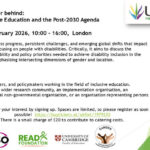Deadline: 700-800 words by 31 May, 2025
A decade has passed since the 2016 World Humanitarian Summit proposed the importance of the ‘Humanitarian-Development-Peace Nexus,’ aiming to bridge the divides between these sectors to achieve collective outcomes. The Humanitarian-Development-Peace Nexus emphasizes the interconnections between humanitarian aid, development, and peacebuilding efforts. It advocates for collaborative approaches to effectively address crises and promote sustainable development, to better serve affected communities. This NORRAG Policy Insights collection seeks to examine how the features of the Nexus can inform–or have informed–education in emergencies programming:
- Integrated Collaboration: Encourages humanitarian, development, and peace actors to work together towards shared goals, leveraging their unique strengths to reduce needs, risks, and vulnerabilities.
- Local Ownership: Emphasizes the active involvement of local authorities and communities in decision-making processes to enhance the effectiveness and sustainability of interventions.
- Context-Specific Approaches: Recognizes the importance of local leadership in tailoring strategies to local contexts, ensuring that interventions are relevant and responsive to the specific needs of affected populations.
- Collective Outcomes: Focuses on achieving common objectives over multiple years, aligning efforts across sectors to ensure long-term, sustainable impact.
- Conflict Sensitivity and Peace Promotion: Ensures conflict-sensitive practices are at the heart of programming, aiming to mitigate potential harm and contribute to social cohesion and peacebuilding efforts.
- Flexible and Multi-Year Financing: Advocates for adaptable funding mechanisms that support long-term planning and can adjust to evolving circumstances, facilitating sustained engagement across the nexus.
Despite numerous initiatives and policy reforms, the practical implementation of the Nexus has encountered significant challenges. Funding silos persist, competition and duplication between actors is rife, coordination among diverse actors can be difficult, and working through fundamental tensions between the three aspects of the Nexus is often a struggle. These issues have been particularly evident in the education sector, where the integration of emergency response, long-term development and peace-building or -preserving remains complex.
To critically assess progress towards nexus-oriented ways of working, to reflect on the implications of current geopolitical complexities, and to chart a future course, we invite contributions for the upcoming edited Policy Insights collection, “The Triple Nexus at 10: What We’ve Learned and Where We Go From Here.” This publication seeks to compile insights, experiences, and research findings that reflect on the past decade of Nexus implementation, with a particular focus on education in emergencies (EiE). We welcome submissions that explore, but are not limited to, the following major themes:
- Education and the Grand Bargain (E.g. localizing and contextualizing global education in emergencies standards and programming)
- From Acute Emergencies to Protracted Crises (E.g. Transitioning from emergency to development approaches and sustaining policy and practice)
- De-siloing, De-centralising, and De-colonizing: The future of education in emergencies

